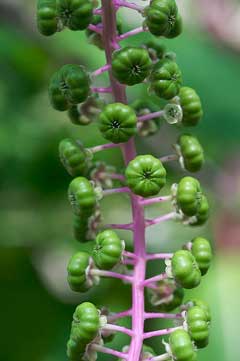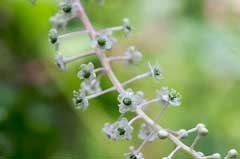 |
|
www.flickr.com/photos/foliosus |
 |
| www.flickr.com/photos/foliosus |
Translate this page:
Summary
Physical Characteristics

 Phytolacca esculenta is a PERENNIAL growing to 1 m (3ft 3in).
Phytolacca esculenta is a PERENNIAL growing to 1 m (3ft 3in).
See above for USDA hardiness. It is hardy to UK zone 6 and is not frost tender. It is in flower from July to August, and the seeds ripen from August to September. The species is hermaphrodite (has both male and female organs).
Suitable for: light (sandy), medium (loamy) and heavy (clay) soils. Suitable pH: mildly acid, neutral and basic (mildly alkaline) soils. It can grow in semi-shade (light woodland) or no shade. It prefers moist soil.
UK Hardiness Map
US Hardiness Map
Synonyms
P. acinosa esculenta. P. kaempferi.
Plant Habitats
Woodland Garden Sunny Edge; Dappled Shade; Cultivated Beds;
Edible Uses
Edible Parts: Leaves Root
Edible Uses:
Leaves - they must be cooked and are used as a spinach[1, 58, 105, 174, 183]. Only the young leaves should be used since they become toxic with age. Root - cooked[105, 183].
References More on Edible Uses
Medicinal Uses
Plants For A Future can not take any responsibility for any adverse effects from the use of plants. Always seek advice from a professional before using a plant medicinally.
Abortifacient Antiasthmatic Antibacterial Antifungal Antiinflammatory Antiphlogistic Antitussive Diuretic
Expectorant Hypotensive Purgative
The roots contain saponins[279]. They are abortifacient, antiasthmatic, antibacterial, antifungal, antiinflammatory, antiphlogistic, antitussive, diuretic, expectorant, hypotensive and purgative[147, 174, 176, 279]. A decoction is used in the treatment of oedema, beri-beri, lumbago, rheumatism, abdominal distension and numbness of the throat[147, 176, 279]. Use with caution, see the notes above on toxicity[176].
References More on Medicinal Uses
The Bookshop: Edible Plant Books
Our Latest books on Perennial Plants For Food Forests and Permaculture Gardens in paperback or digital formats.

Edible Tropical Plants
Food Forest Plants for Hotter Conditions: 250+ Plants For Tropical Food Forests & Permaculture Gardens.
More

Edible Temperate Plants
Plants for Your Food Forest: 500 Plants for Temperate Food Forests & Permaculture Gardens.
More

More Books
PFAF have eight books available in paperback and digital formats. Browse the shop for more information.
Shop Now
Other Uses
Ink
A red ink is obtained from the fruit[57].
Special Uses
References More on Other Uses
Cultivation details
An easily grown plant, succeeding in most soils[1], though preferring a moisture retentive soil in full sun or partial shade[200]. We have found the plants to be very tolerant of drought[K]. Plants can be grown in quite coarse grass, which can be cut annually in the autumn[233]. The young growth in spring can be damaged by late frosts. There is sme disagreement over the correct name for this species with some authorities saying that it is no more than a synonym for P. acinosa[266], whilst others give it specific status[200]. There are reports that there is a white flowered plant, which could either be this species or a form of P. acinosa which is said to be non-toxic and to have an edible root[K]. See P. acinosa for more details. Plants seem to be immune to the predations of rabbits[233].
References Carbon Farming Information and Carbon Sequestration Information
Temperature Converter
Type a value in the Celsius field to convert the value to Fahrenheit:
Fahrenheit:
The PFAF Bookshop
Plants For A Future have a number of books available in paperback and digital form. Book titles include Edible Plants, Edible Perennials, Edible Trees,Edible Shrubs, Woodland Gardening, and Temperate Food Forest Plants. Our new book is Food Forest Plants For Hotter Conditions (Tropical and Sub-Tropical).
Shop Now
Plant Propagation
Seed - sow autumn or spring in a cold frame[200]. When they are large enough to handle, prick the seedlings out into individual pots and grow them on in the greenhouse for their first winter. Plant them out into their permanent positions in late spring or early summer, after the last expected frosts. If you have sufficient seed, it might be worthwhile trying an outdoor sowing in a seed bed in early spring. Grow the plants on in the seedbed for their first year and plant them out the following spring. Division in March or October. Use a sharp spade or knife to divide the rootstock, making sure that each section has at least one growth bud. Very easy, larger divisions can be planted out direct into their permanent positions. We have found that it is better to pot up the smaller divisions and grow them on in light shade in a cold frame until they are well established before planting them out in late spring or early summer.
Other Names
If available other names are mentioned here
Native Range
TEMPERATE ASIA: China (Anhui Sheng, Fujian Sheng, Guangdong Sheng, Guangxi Zhuangzu Zizhiqu, Hebei Sheng, Henan Sheng, Hubei Sheng, Jiangsu Sheng, Liaoning Sheng, Shaanxi Sheng, Shandong Sheng, Sichuan Sheng, Xizang Zizhiqu, Yunnan Sheng, Zhejiang Sheng), Korea, Japan, Taiwan TROPICAL ASIA: Bhutan, India, Myanmar, Vietnam
Weed Potential
Right plant wrong place. We are currently updating this section.
Please note that a plant may be invasive in one area but may not in your area so it's worth checking.
Conservation Status
IUCN Red List of Threatened Plants Status :

Growth: S = slow M = medium F = fast. Soil: L = light (sandy) M = medium H = heavy (clay). pH: A = acid N = neutral B = basic (alkaline). Shade: F = full shade S = semi-shade N = no shade. Moisture: D = dry M = Moist We = wet Wa = water.
Now available:
Food Forest Plants for Mediterranean Conditions
350+ Perennial Plants For Mediterranean and Drier Food Forests and Permaculture Gardens.
[Paperback and eBook]
This is the third in Plants For A Future's series of plant guides for food forests tailored to
specific climate zones. Following volumes on temperate and tropical ecosystems, this book focuses
on species suited to Mediterranean conditions—regions with hot, dry summers and cool, wet winters,
often facing the added challenge of climate change.
Read More
Expert comment
Author
Van Houtte.
Botanical References
200266
Links / References
For a list of references used on this page please go here
Readers comment
| Add a comment |
|
If you have important information about this plant that may help other users please add a comment or link below. Only comments or links that are felt to be directly relevant to a plant will be included. If you think a comment/link or information contained on this page is inaccurate or misleading we would welcome your feedback at [email protected]. If you have questions about a plant please use the Forum on this website as we do not have the resources to answer questions ourselves.
* Please note: the comments by website users are not necessarily those held by PFAF and may give misleading or inaccurate information.
To leave a comment please Register or login here All comments need to be approved so will not appear immediately.
|
Subject : Phytolacca esculenta
|
|
|
|